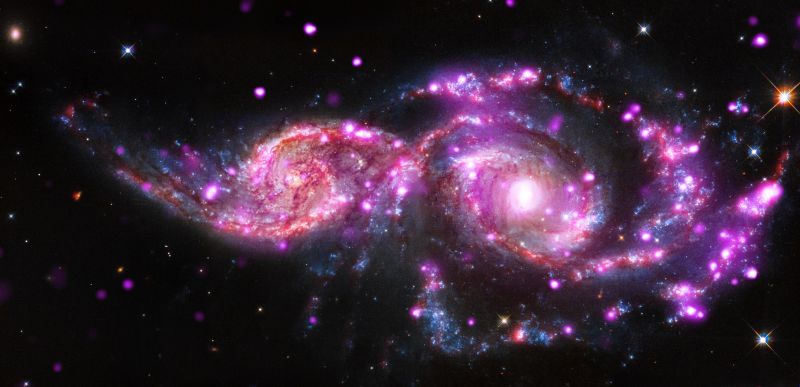
Ann K. Schwader
Distant Deaths of Galaxies
The distant deaths of galaxies
disturb the surface of our sleep,
disclosing cataclysms deep
& yet familiar. All of these
sad spirals with their energies
stripped off by darkness warn us: keep
what’s sacred secret. Safe. No cheap
diversions, shadow dives to ease
the pangs of starbirth. Soon enough
& few enough, our final sparks
cool into void, rejoining dreams
this universe abandoned. Snuffed
husks linger like graffiti marked
on rocks that cross a lightless stream.
Ann K. Schwader’s poems have recently appeared in Spectral Realms, Dreams & Nightmares, Star*Line, and dust devils, The Red Moon Anthology of English-Language Haiku 2016. Her most recent collection, Dark Energies (P’rea Press 2015) was a Bram Stoker Award Finalist.
Editor’s Note: When galaxies get together, they also may be surrounded by a spectacular light show. That’s the case with NGC 2207 and IC 2163, which are located about 130 million light-years from Earth, in the constellation of Canis Major.
This pair of spiral galaxies has been caught in a grazing encounter. NGC 2207 and IC 2163 have hosted three supernova explosions in the past 15 years and have produced one of the most bountiful collections of super-bright X-ray lights known. These special objects — known as “ultraluminous X-ray sources” (ULXs) — have been found using data from NASA’s Chandra X-Ray Observatory.
This composite image of NGC 2207 and IC 2163 contains Chandra data in pink, optical-light data from NASA’s Hubble Space Telescope visible-light data in blue, white, orange and brown, and infrared data from NASA’s Spitzer Space Telescope in red.
More information about the image is online at http://chandra.harvard.edu/photo/2014/ngc2207.
Image credit: NASA/CXC/SAO/STScI/JPL-Caltech

Pingback: Member News- November, 2017 – SPECPO